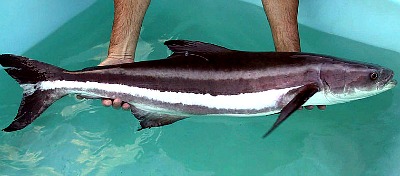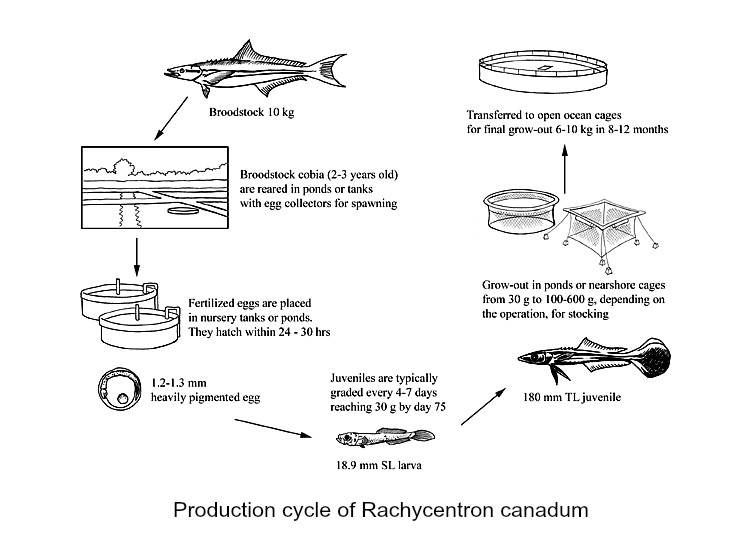 Cobia (Rachycentron canadum), a warm water fish also known as black kingfish, black salmon, ling, lemonfish, crabeaters, aruan tasek, etc., and considered one of the most suitable candidates for warm, open-water marine fish aquaculture in the world. Cobia are large pelagic fish, up to 2 meters (78 inches) long and 68 kilograms (150 pounds) in weight. They are solitary fish except when spawning, found in warm-temperate to tropical waters. Their rapid growth rate in aquaculture, as well as the high quality of their flesh, makes cobia potentially one of the more important potential marine fish for aquaculture production.
Cobia (Rachycentron canadum), a warm water fish also known as black kingfish, black salmon, ling, lemonfish, crabeaters, aruan tasek, etc., and considered one of the most suitable candidates for warm, open-water marine fish aquaculture in the world. Cobia are large pelagic fish, up to 2 meters (78 inches) long and 68 kilograms (150 pounds) in weight. They are solitary fish except when spawning, found in warm-temperate to tropical waters. Their rapid growth rate in aquaculture, as well as the high quality of their flesh, makes cobia potentially one of the more important potential marine fish for aquaculture production.
Currently, cobia are being cultured in nurseries and grow-out offshore cages many parts of Asia and off the coast of US, Mexico and Panama.
HABITAT AND BIOLOGY
Cobia are distributed worldwide in warm marine waters, except for the central and eastern Pacific, resulting in a very large potential area suitable for the production of native species. They can be found throughout the water column and are caught in both coastal and continental shelf waters, although they are typically considered to be an offshore species. Wild-caught cobia do not support a major commercial fishery and are uncommon throughout its range and generally considered incidental catch. They are often found associated with structures of various kinds, such as oil and gas platforms, weed lines, buoys, turtles, rays, and any type of flotsam.
Cobia prefer warm water (>20ºC) and typically have annual migratory patterns that are established and predictable. In the northwestern Gulf of Mexico, they arrive in the spring and can be caught into the early fall, spawning multiple times from April to September, with activity peaking in July. Sexual maturity is reported in males at 1-2 years and in females at 2-3 years, with females growing both larger and faster with maximum sizes up to 60 kg. Spawning occurs in both nearshore and offshore waters where females release several hundred thousand to several million eggs (1.4 mm diameter) which are then fertilized by the attending males. The viable eggs begin development, are heavily pigmented, buoyant, and hatch in approximately 24 hours. Cobia larvae grow rapidly and are large in comparison to most marine species at 3.5 mm TL at hatching. Juvenile fish are found in both nearshore and offshore waters, often among Sargassum patches or weed lines where they seek shelter from predators and can feed. Cobia are opportunistic feeders and examinations of stomach contents have revealed various fish, shrimp, squid, and, in particular, crabs.

How to culture Cobia:
PRODUCTION SYSTEMS
Seed Supply
Although the majority of cobia aquaculture production currently comes from China, most of the detailed information about culture and grow-out methods is reported from Taiwan Province of China. Here, brood stock fish for spawning were initially caught from the wild; however, after the species became subsequently farmed, 1.5-2 year old cobia (approximately 10 kg) are now selected from the grow-out cages and transported to onshore ponds. These spawning ponds (400-600 m2 and 1.5 m deep) are stocked with 100 adult cobia at a sex ratio of 1:1. These spawn naturally year round, with peaks in the spring and fall when water temperatures are 23-27ºC.
Spawning efforts in the USA have also been successful, utilizing round fiberglass tanks 5.5-6.0 m in diameter and 1.5-1.8 m deep to hold adult cobia. The tanks have an egg collector and are either operated as recirculating systems, flow-through, or a combination of both, depending on the biological filtration capacity of the system. Brood stock collection generally involves capturing and transporting juvenile or adult wild-caught cobia (often during their natural spawning season) into the tank systems, where 2-3 year old fish will spawn either naturally or after being induced with photo-period and temperature manipulations. Research on maintaining and extending the cobia spawning season in the USA has resulted in the production of fertilized eggs during 10 months of the year thus far, with the goal of realizing year-round egg production in the future.
Cobia seed stock used for large scale commercial aquaculture production comes exclusively from hatcheries.
Hatchery Production
Cobia are spawned and fertilized eggs are collected, either from tanks or spawning ponds. After hatching and absorbing the yolk sac (usually by day 3), the larval cobia must initially be provided adequate amounts of the proper size food, such as enriched rotifers (Brachionus plicatilis) or copepod nauplii. In tank systems this food should be offered for at least the first four days, after which enriched, newly hatched enriched Artemia can be introduced, followed by weaning to dry feed at approximately 25-30 days post-hatch. The rearing density of cobia in tank systems during the early stages remains a challenging aspect of culture that will need to be improved upon for scaling to commercial viability. So far, a modest harvest of 1 fish/liter after weaning, regardless of the initial stocking rate is normal, although some promising research in the USA during 2005-2006 has resulted in the production of over 2 fish/litre and researchers are hoping to double that number in future trials.
Nursery
In Taiwan Province of China, cobia are reported to be raised in a series of outdoor ponds until they reach a large enough size to be stocked into a nearshore or offshore grow-out cage system. During the larval rearing stage, ‘green water’ nursery ponds <5 000 m2 in area and 1-1.2 m deep with an adequate bloom of Chlorella, copepods, and rotifers are utilized. This method typically results in larval survival of 5-10 percent from hatch to day 20, after which time the fish are moved to two or three pond systems during the next 2 months, depending on the characteristics of the operation.
To reduce cannibalism and size variability cobia are graded weekly after day 45 post-hatch until they reach approximately 30 g (around day 75 post-hatch), which is considered the minimum size for stocking in cages. Cobia are fed 5-6 times a day to satiation at a rate of 5 percent body weight up to 30 g; after this the feeding rate is reduced to 2-3 percent body weight as the fish approaches 200 g. Some producers continue raising the juvenile fish from 30 g up to 600-1 000 g in outdoor ponds, while others use smaller (20-200 m3) nearshore cages. From this point onwards the overall goal, whether in ponds or cages, is to raise the young cobia to a point where they are large enough to be stocked into a grow-out cage system, yet small enough to be transported in large numbers with minimal mortality.
On-growing Techniques
Early on in the cobia production cycle Taiwanese methods, which utilize outdoor ponds for brood stock and nursery phases, tend to be more extensive when compared to current efforts in the USA, which typically involve tank culture of brood stock and early juveniles. From that point on however, grow-out methods are similar in both locations, as they utilize net pens or cages of various sizes and types to rear the cobia to harvestable size.
Successful grow-out of cobia has been reported in nearshore and offshore cages, utilizing both surface and submerged systems during the longest and final stage of production. Taiwanese producers use 1 000-2 000 m3 cages, while some operations in the Caribbean have used 3000m³ submersible systems successfully. In order to minimize grow-out time as well as disease issues, cobia produced in cages should be located in sites that provide warm (26ºC and above) clean water and adequate flow rates through the cage system to provide high dissolved oxygen levels continuously. Harvest numbers vary depending on the stocking rates and water temperature, but the grow-out period for pellet fed cobia is generally about 1-1.5 years, with fish reaching a final weight of 6-10 kg at harvest densities of 10-15 kg/m3.
Feed Supply
Cobia producers in Taiwan Province of China use both floating and sinking pellets (42-45 percent crude protein, and 15-16 percent lipid), typically fed 6 days a week at a rate of 0.5-0.7 percent BW/day towards the end of the grow-out phase. Cobia feed conversion in Taiwan Province of China is reported to be approximately 1.5:1. Operations in the Caribbean have used pellets manufactured in the USA that are typically higher in crude protein (50- 53 percent) with 10-15 percent lipid content.
Harvesting Techniques
It is reported that producers in Taiwan Province of China make selective or partial harvests of cobia from cages allowing them to meet current market demands, whether the fish are consumed domestically or destined for export. Little published information is available regarding cage harvest methods for cobia, although they would certainly be site specific and likely to employ techniques to crowd and net or pump fish and place them into a chilled container on a tending vessel, similar to those used in salmon farming.
Handling and Processing
Cobia in Taiwan Province of China are typically starved the day before harvest and 6 kg fish or larger are selected, killed, bled and chilled before whole fish or fillets are packed in ice. Cobia enters the market whole/gutted, headless, or filleted, depending on the final market destination.
Production Costs
Information on production costs for this species is minimal but was said to be approximately USD2.20/kg in Taiwan Province of China in 2001, a figure which was noted to be very competitive with several other species of marine fish being cultured.
Sources and Photos: en.wikipedia.org, www.fao.org